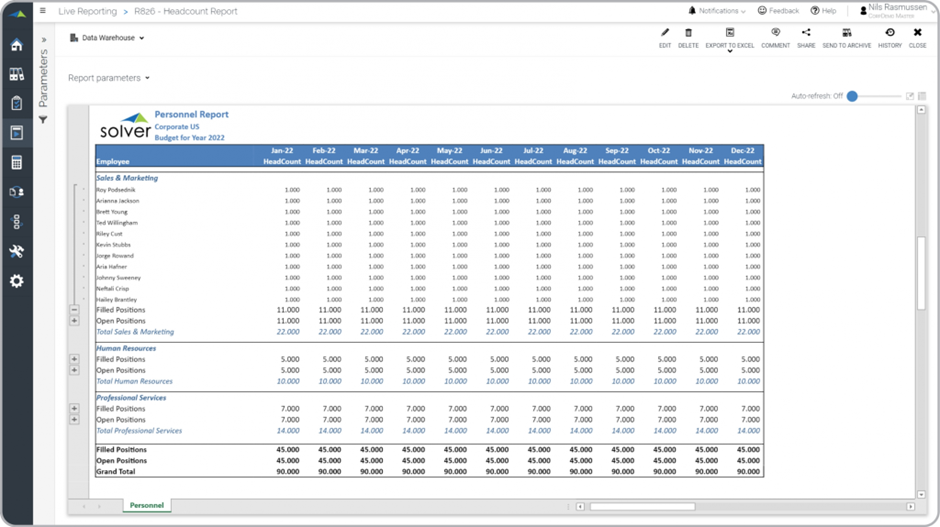When it comes to business, there are a lot of numbers and jargon that can be confusing for the average person. Headcount is one such term. Many people have no idea what it means or what function it serves in a company. This article will help clarify things by explaining headcount, its purpose, and some of the pros and cons of having a high or low headcount. By the end of this post, you’ll have a better understanding of what headcount is and why it matters.
What Is Headcount?
Headcount is a term used to describe the number of people employed by a company or organization. It is often used as a way to measure the size of a business and can be used to compare the growth of different firms over time.
Headcount can also be used to measure a company’s productivity, as it can be used to calculate the average number of employees per unit of output. In addition, headcount can be used to assess the financial health of a company, as it can be used to calculate the ratio of debt to equity. As such, a headcount is a versatile tool that can be used in many different ways.
Why Is It Important For Businesses To Track Their Headcount?
There are a few key reasons businesses should track their headcount. First, it can help you to identify areas where you may be overstaffed or understaffed. This information can be used to make adjustments to your workforce, which can help to improve efficiency and save money.
Second, tracking headcount can help you to identify trends in your workforce. For example, if you notice that your headcount is increasing rapidly, it may be an indication that your business is growing and you will need to hire additional staff.
Conversely, if your headcount is decreasing, it may be an indication that you need to make cuts to your workforce.
Finally, tracking headcount can help you to create accurate budget projections. Accurate projections are essential for all businesses in order to ensure that they are able to meet their financial obligations.
How Do You Calculate Headcount?
There are a few different ways that you can calculate headcount for your company. The most basic method is simply to tally up the total number of employees and consultants that are on your payroll.
However, if you are looking for a more accurate measure of your company’s size, you can calculate the number of Full-Time Equivalents (FTE). To do this, you will need to divide the total number of weekly hours worked in your company by the standard number of working hours per week. This will give you a more accurate measure of your company’s size and allow you to compare it more effectively to other businesses.
Here’s the formula:
Total # weekly hours being worked in the company / # standard working hours per week = Full-Time Equivalent (FTE)
What Factors Affect Headcount?
There are many factors that can affect the headcount of a company. Some of those include:
Market conditions:
If the market is performing poorly, companies may be forced to reduce their headcount in order to stay afloat. On the other hand, a booming economy can lead to an increase in headcount as businesses expand and hire more staff members.
Corporate structure:
The type of corporate structure (whether it’s a sole proprietorship, corporation, or other business entity) can affect the number of people working for the company. For example, in a sole proprietorship, there is only one employee – the owner.
Company size:
Generally speaking, larger companies tend to have higher headcounts than smaller ones. This is due to the fact that larger companies typically have more complex operations which require more people to manage.
Competition:
The level of competition in a particular industry can also affect headcount, as companies may hire additional staff in order to stay ahead of their competitors and gain a competitive advantage.
Overall, headcount is an important tool for businesses to use when measuring their size, productivity, and financial health. It is important to understand what factors can affect headcount in order to accurately assess the performance of a company.
What Are The Effects Of Headcount On A Business?
Headcount is a crucial factor in the success or failure of any business. Having too few employees can lead to customer dissatisfaction, missed opportunities, and an overall loss of productivity. On the other hand, having too many employees can lead to a decrease in efficiency and an increase in expenses due to salaries and benefits. Therefore, it’s important for businesses to carefully consider the effects of headcount and ensure it is at optimal levels.
The most obvious effect of headcount is on productivity, as too few employees can lead to backlogs in customer orders or services and missed deadlines. This leads to unhappy customers and lost sales opportunities, which negatively impacts a business’s bottom line. On the other hand, too many employees can lead to duplication of tasks and inefficient use of resources.
Headcount also has a direct impact on morale. Having too few employees can lead to overworked staff and burnout while having too many employees can lead to boredom and lack of motivation due to inefficiencies or redundancies. Both scenarios can lead to a decrease in productivity and increased turnover.
Finally, headcount can have an impact on the overall budget of a business as too many employees can add substantially to fixed costs. This can reduce profits and negatively affect cash flow, leading to difficulty paying bills or investing in new resources.
Ultimately, businesses should strive for an optimal headcount that allows them to maintain productivity and customer satisfaction, while not overspending on salaries and other overhead costs. Having the right number of employees ensures a business runs efficiently, effectively, and profitably.
What Is A Good Headcount?
The size of your company is an important factor to consider when determining your headcount. The number of employees you have will influence how much work can be accomplished and how efficiently your company runs. A good headcount will ensure that you have enough staff to complete the work required, but not so many that you are overstaffed and wasting resources.
The best way to determine the ideal headcount for your company is to carefully assess the work that needs to be done and the skills of your current staff. With this information, you can determine how many additional staff members you need and what specific skills they should possess. By ensuring that your headcount is appropriate for the size and needs of your company, you can optimize efficiency and productivity.
Example Of Headcount
Here is an example of a comprehensive Compensation and Headcount Variance report. This report provides a detailed breakdown of the differences in compensation and headcount between expected values and actual outcomes. It includes salary, benefits, and other costs associated with staffing levels. The report also takes into account any changes in classification or job duties that may have occurred during the reporting period. The report provides an accurate and useful overview of the human resource costs that are associated with a company or organization’s operations.

Strategies For Improving The Headcount Process
Incorporate Automation:
Automating the headcount process can be a great way to ensure accuracy and save time, as well as increase efficiency in tracking the number of employees in an organization. By utilizing software that allows for automatic updates on employee headcounts, it is easier to keep track of who is employed at any given moment.
Streamline Communication:
Ensuring that all of the pertinent parties in an organization are on the same page with regard to headcounts is essential for successful tracking and management. Utilizing efficient communication methods, such as email or text alerts when employee counts changes arise can help to keep everyone informed and up-to-date.
Evaluate Policies & Procedures:
Ensuring that all of the policies and procedures in place for headcount tracking are up to date, accurate, and effective can help to simplify the process and make it easier to manage. Taking a critical look at existing practices and making updates accordingly can be extremely beneficial in keeping track of employee headcounts.
Utilize Data & Analytics:
Taking advantage of data and analytics tools can be a great way to further streamline the headcount process and make it easier to understand how employee headcounts are changing over time and what factors are driving these changes. This can help organizations better anticipate future needs and ensure that they have the proper staffing levels in place.
Incorporate Feedback:
Gathering feedback from employees and other stakeholders can be a great way to further simplify the headcount process. Investigating what processes are working well and which ones could use some tweaking or improvement can help organizations make more informed decisions when it comes to tracking employee headcounts.
Invest in Training:
Providing training for staff on the headcount process and how to use any related software or tools can be a great way to ensure accuracy and reduce potential errors. This can also help to ensure that all employees are on the same page when it comes to tracking employee headcounts, making it easier to manage.
Invest in Technology:
Updating headcount tracking technology can be a great way to further streamline the process and make it easier for everyone involved. From automating processes to providing data analytics tools, investing in the right technology can help organizations stay ahead of the game when it comes to tracking employee headcounts.
Document Everything:
Ensuring that all headcount changes are properly documented is essential for accuracy and compliance with any relevant laws or regulations. Documenting everything in a central location can help to simplify the process and make it easier to keep track of employee headcounts over time.
Monitor Performance:
Keeping an eye on performance metrics related to headcount tracking can be a great way to ensure that processes are running smoothly. Monitoring these metrics can help identify any areas where improvements or corrections may need to be made in order to further improve the headcount process.
Review Regularly:
Finally, it is important to review the headcount process regularly in order to stay ahead of any potential issues and ensure accuracy. Taking a look at the process on a regular basis can help to make sure that everything is running smoothly and that any necessary changes can be made in a timely manner.
These are just some of the ways that organizations can simplify their headcount tracking processes. Implementing these strategies can help to ensure that the process runs smoothly and that organizations have access to up-to-date employee headcounts.
Conclusion
As your business grows, it becomes more important to keep track of your employee headcount. This number can help you in many ways – from understanding how much office space you need, to budgeting for raises or promotions. By tracking headcount, you’ll always have a finger on the pulse of your company’s growth.

